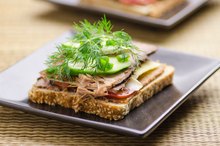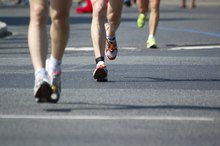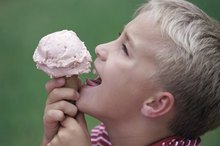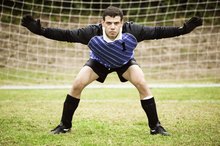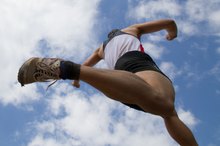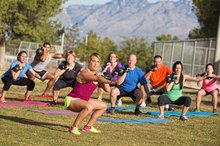A Male Gymnast's Diet
Extraordinarily fit, elite male gymnasts are lean with powerful muscles, as well as being agile and flexible. While training is important in achieving physical and athletic goals, so is diet. The ideal male gymnast's diet is aimed at getting enough calories and filling up with the right amount of carboydrates, protein and fat.
High-Calorie Needs
While training, male gymnasts need to eat enough calories to maintain muscle mass and promote muscle growth. The number of calories you need depends on your age, current weight, height and the amount of time spent training. On average, active men need 3,000 calories per day to maintain a healthy weight, according to the 2010 Dietary Guidelines for Americans 3. Monitoring your calorie intake and body weight can help you determine how many calories you need each day.
- While training, male gymnasts need to eat enough calories to maintain muscle mass and promote muscle growth.
- Monitoring your calorie intake and body weight can help you determine how many calories you need each day.
Balancing Carbs, Protein and Fat
The Perfect Distance Runner's Diet
Learn More
The ideal diet for a male gymnast is high in carbohydrates, moderate in protein and low in fat, according to Dr. A Jay Binder, member of the medical commission of the Federation of International Gymnastics 1. Carbohydrates act as an efficient source of energy for muscles. Carbs such as fruit and potatoes provide a quick source of energy, while whole-grain breads and cereals, pasta and beans provide a longer-lasting steady source of energy. Protein is important for maintaining and growing muscle. Lean meats, eggs, fish, beans and low-fat milk are good sources of protein. Leanness might be your goal, but you still need some fat in your diet. A male gymnast should get at least 20 percent of calories from healthy sources of fat such as nuts, olive oil and fatty fish such as salmon.
- The ideal diet for a male gymnast is high in carbohydrates, moderate in protein and low in fat, according to Dr. A Jay Binder, member of the medical commission of the Federation of International Gymnastics 1.
It's All in the Plating
Use your plate as a guide to help you get the right amount of carbs, protein and fat. Sports dietitian Nancy Clark suggests you fill two-thirds to three-quarters of your plate with carbs, and one-quarter to one-third of your plate with protein. The fat in your diet comes from the oils used during cooking and the fat naturally found in foods such as chicken, fish and low-fat milk. For example, a healthy male gymnast's breakfast meal might include whole-wheat toast and fresh cantaloupe with hard-boiled eggs and a glass of low-fat milk. For lunch, fill your plate with brown rice, broccoli and a grilled chicken breast. A healthy dinner meal might include a baked sweet potato with roasted vegetables and salmon.
- Use your plate as a guide to help you get the right amount of carbs, protein and fat.
- For example, a healthy male gymnast's breakfast meal might include whole-wheat toast and fresh cantaloupe with hard-boiled eggs and a glass of low-fat milk.
High-Energy Snacks
Duathlon Training & Diet
Learn More
Snacks are an important part of your diet plan. Eating small snacks throughout the day helps you meet your high-energy needs and improves performance and recovery. Snacks should include a source of carbohydrates and protein, such as whole-wheat crackers with peanut butter, yogurt and a banana, or dried fruit and nut mix. It is especially important that you eat a snack after training or competition to replenish energy stores and promote muscle healing.
- Snacks are an important part of your diet plan.
- It is especially important that you eat a snack after training or competition to replenish energy stores and promote muscle healing.
Related Articles
References
- Australian Sports Commission: Gymnastics
- USA Gymnastics: Weight Management
- U.S. Department of Agriculture and U.S. Department of Health and Human Services: Dietary Guidelines for Americans, 2010
- Accelerations Gymnastics Academy: Nutrition
- Correction to: Impact of whole dairy matrix on musculoskeletal health and aging–current knowledge and research gaps | SpringerLink
- FoodData Central
- Milk Nutrients Augment Muscle Growth and Recovery - International Milk Genomics Consortium
- Nutrients | Free Full-Text | The Role of the Anabolic Properties of Plant- versus Animal-Based Protein Sources in Supporting Muscle Mass Maintenance: A Critical Review
- FoodData Central
- FoodData Central
- FoodData Central
- None
- Leucine | C6H13NO2 - PubChem
- Important roles of dietary taurine, creatine, carnosine, anserine and 4-hydroxyproline in human nutrition and health | SpringerLink
- Protein-enriched diet, with the use of lean red meat, combined with progressive resistance training enhances lean tissue mass and muscle strength and reduces circulating IL-6 concentrations in elderly women: a cluster randomized controlled trial - PubMed
- None
- Role of resistant starch in improving gut health, adiposity, and insulin resistance - PubMed
- Omega-3 Fatty Acids - Consumer
- None
- None
- Redirecting
- Protein content and amino acid composition of commercially available plant-based protein isolates
- Pairing nuts and dried fruit for cardiometabolic health | Nutrition Journal | Full Text
- Error
- None
- Effects of Probiotics, Prebiotics, and Synbiotics on Human Health
- FoodData Central
- FoodData Central
- Benefits of Breakfast Cereal Consumption: A Systematic Review of the Evidence Base | Advances in Nutrition | Oxford Academic
- None
- FoodData Central
- Error
- Error
- Error
- None
- None
- FoodData Central
Writer Bio
Jill Corleone is a registered dietitian and health coach who has been writing and lecturing on diet and health for more than 15 years. Her work has been featured on the Huffington Post, Diabetes Self-Management and in the book "Noninvasive Mechanical Ventilation," edited by John R. Bach, M.D. Corleone holds a Bachelor of Science in nutrition.
